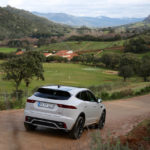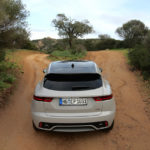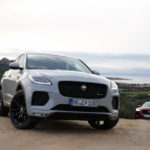Give Jaguar’s head of design, Ian Callum, any vehicle segment, and he’ll make it alluring. That seems to be the lesson of the last few years, as the U.K. automaker converts Tata Motors’ investment into automotive currency. But sedans and sports cars, with their low-slung physiques, are far more receptive to dynamic design than tall, wheel-gapped SUVs.
Molding Jaguar’s first crossover was a challenge only Callum was equipped to handle. Indeed, it’s difficult to imagine the F-Pace looking any other way. Customers seem to agree – the F-Pace has quickly become the brand’s best-selling model. Even so, Jaguar production is merely a rounding error for rivals like BMW and Mercedes-Benz. The company needs another volume play.
A premium compact SUV has the potential to cement Jaguar within the luxury car conversation, but look among the current players – BMW’s X1, Mercedes-Benz’s GLA, and Audi’s Q3 – and you’ll find little evidence of inspired design. This begs the question: is an attractive compact SUV, with its stubby proportions and restrictive price point, even possible?
Callum and his team answer with the E-Pace. Cute yet fierce (not unlike a Jaguar cub), the E-Pace borrows the right styling cues from its F-Pace and F-Type family members, while introducing its own flourishes. Priced from $38,500, Jaguar’s second SUV, and new entry-point, is life breathed into an accountant-ordained segment – at least on the surface. For the full picture, read our 2018 Jaguar E-Pace first drive review below.
Luxury and Tech
The E-Pace’s cabin distinctly communicates the car’s departure from the norm. Certain elements, like the thick-rimmed steering wheel, passenger grab handle, and angled dashboard are sourced directly from the F-Type sports car. Other signatures, including the center stack’s rotary climate control dials with digital inserts, are shared with the Land Rover Range Rover Evoque (upon which the E-Pace platform is loosely based). The combination of these sporty and sumptuous elements is cohesively upscale.
Though its coupe-like silhouette suggests otherwise, the E-Pace is one of the tallest vehicles in its class. Height lends itself to generous headroom for up to five passengers and impressive cargo capacity. However, long-legged rear riders may run into some issues with knee room. With the rear seats in place, the E-Pace boasts 24.2 cubic feet of space – expanding to 52.7 cu. ft. with the seats folded. Only the longer BMW X1 offers more cargo capacity.
There’s a fair bit of intelligence beneath the E-Pace’s striking design as well. A standard 10.0-inch Touch Pro infotainment system fills the center stack with stimulating visuals. The system’s tile-based layout, snappy response, and sharp resolution are segment high-points. A12.3-inch digital driver display, an innovation traditionally reserved for upmarket models, is available in range-topping HSE R-Dynamic trims. Jaguar’s all-new full-color head-up display displays speed limit, navigation, media, and engine data in the driver’s forward view. Two USB ports are standard, and up to five USB connection points are available. A standard InControl app allows users to lock/unlock, set climate control, and check fuel levels via their smartphone. A Wi-Fi hotspot for up to eight devices, 825-watt Meridian 15-speaker sound system, and activity key (waterproof wristband to lock/unlock the car) are optional upgrades.
The 2018 E-Pace tiers its driver assistance systems based on trim, starting with low-speed automatic emergency braking as standard. S models add traffic sign recognition, an adaptive speed limiter (a setting that adjusts the vehicle’s speed based on posted limits), parking assistance, a 360-degree camera, and rear cross traffic alert. SE variants include blind spot monitoring and intervention, full-speed adaptive cruise control, and high-speed automatic emergency braking. While the E-Pace isn’t available with lane-keeping assist like some of its key rivals, its roster of driver aids includes several class-exclusive technologies.
On the tech front, the E-Pace overwhelms the X1, GLA, and Q3 with sophistication and convenience.
Setting The E-Pace
The E-Pace is no sports car, but it does a fine impression of one when faced with a twisty road. As Jaguar’s first front-drive derived model of its all-new lineup, the E-Pace must conquer the physics of understeer. To do that, the SUV uses an active driveline (standard on R-Dynamic models) to shuttle torque between axles and to each rear wheel. When prodded, say, along Corsica’s narrow, serpentine roads, the brake-based torque vectoring system detects grip (not slip) to apply power effectively. When the road straightens and your pace slows, the E-Pace can power just the front wheels to maximize fuel efficiency.
In an entirely different application – off-road – the E-Pace’s sophisticated all-wheel drive system ensures traction over slippery rocks, loose dirt, or bogging mud. Choosing the Rain, Ice, and Snow drive mode (one of four available settings) permits the use of Jaguar’s All Surface Progress Control (ASPC) – a gift from Land Rover’s engineering team. This system operates like low-speed cruise control, allowing drivers to focus on steering input. Though the X1, GLA, and Q3 are each offered with all-wheel drive, none of them can match the E-Pace’s all-terrain tech.
All North American E-Pace models are powered by a 2.0-liter turbocharged four-cylinder and use a new ZF nine-speed automatic transmission. Standard E-Pace SUVs deliver 246 horsepower and 269 pound-feet of torque. R-Dynamic models add 50 hp and 26 lb-ft of torque (the same tune as Jaguar’s F-Type sports car). Regardless of tune, the E-Pace is more powerful than its key rivals, the 228-hp X1 xDrive28i, 208-hp GLA250 4Matic, and 200-hp Q3 Quattro. Balancing the scales, however, is the E-Pace’s trailing mpg ratings. At 28 highway, 21 city, and 24 combined for P250 models (27/21/23 for P300 versions), the E-Pace is down 1 mpg to the X1 and 2 mpg to the GLA in combined ratings. Only the Q3 is less efficient.
Graceful and potent on any surface, the E-Pace balances supple ride quality with precise driving dynamics.
Conclusion
Jaguar anticipates the E-Pace will be among its most popular models, with 80-percent of buyers being new to the brand. Still, the company expects its F-Pace midsize SUV to top sales charts. We have a slightly different prophecy: the E-Pace will become the automaker’s best-selling model to date – trumping even the F-Pace. Jaguar’s “cub” has the right look, technology, and price point to become a smash hit.
The German luxury brands made sliced bread SUVs – useful, but bland. Jaguar added the butter.
















